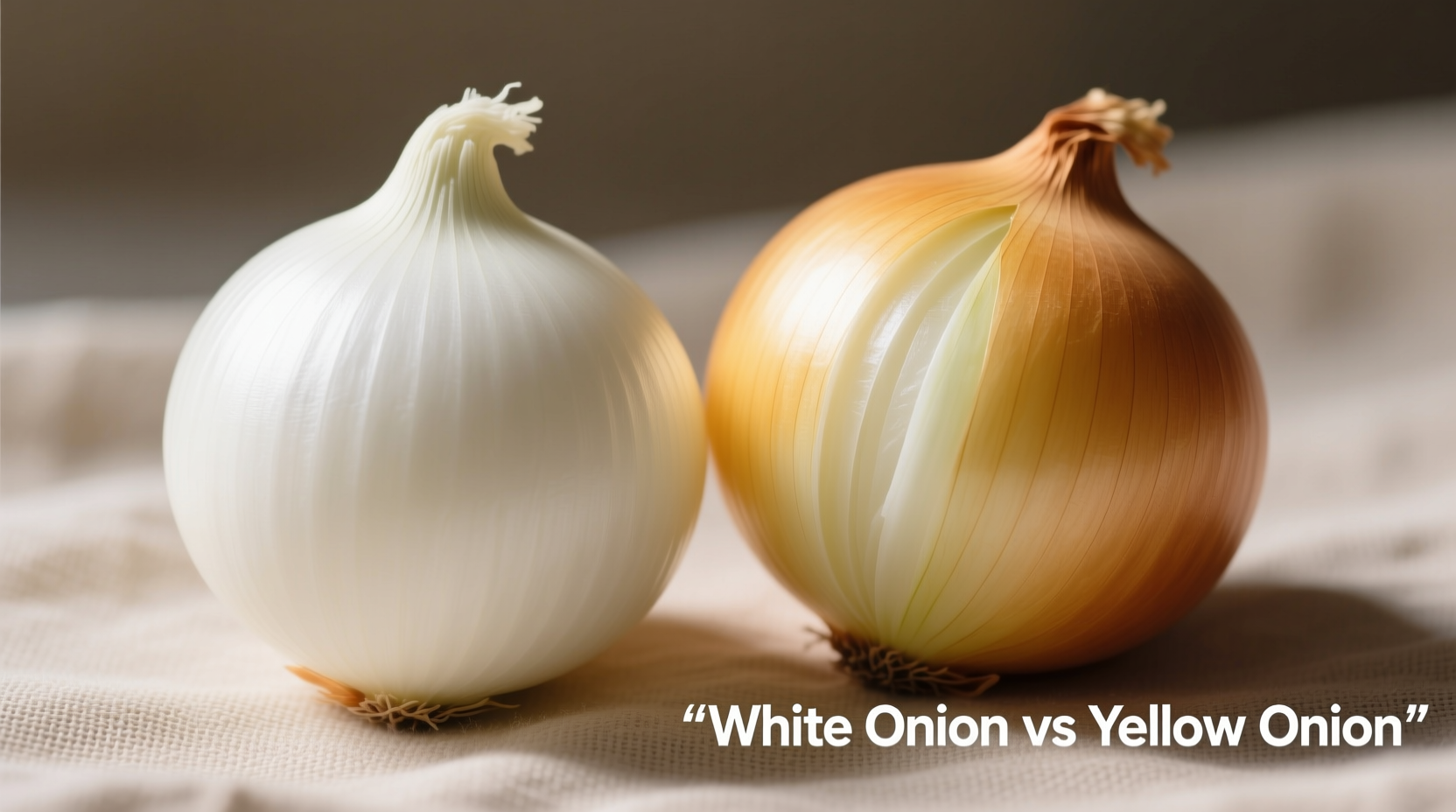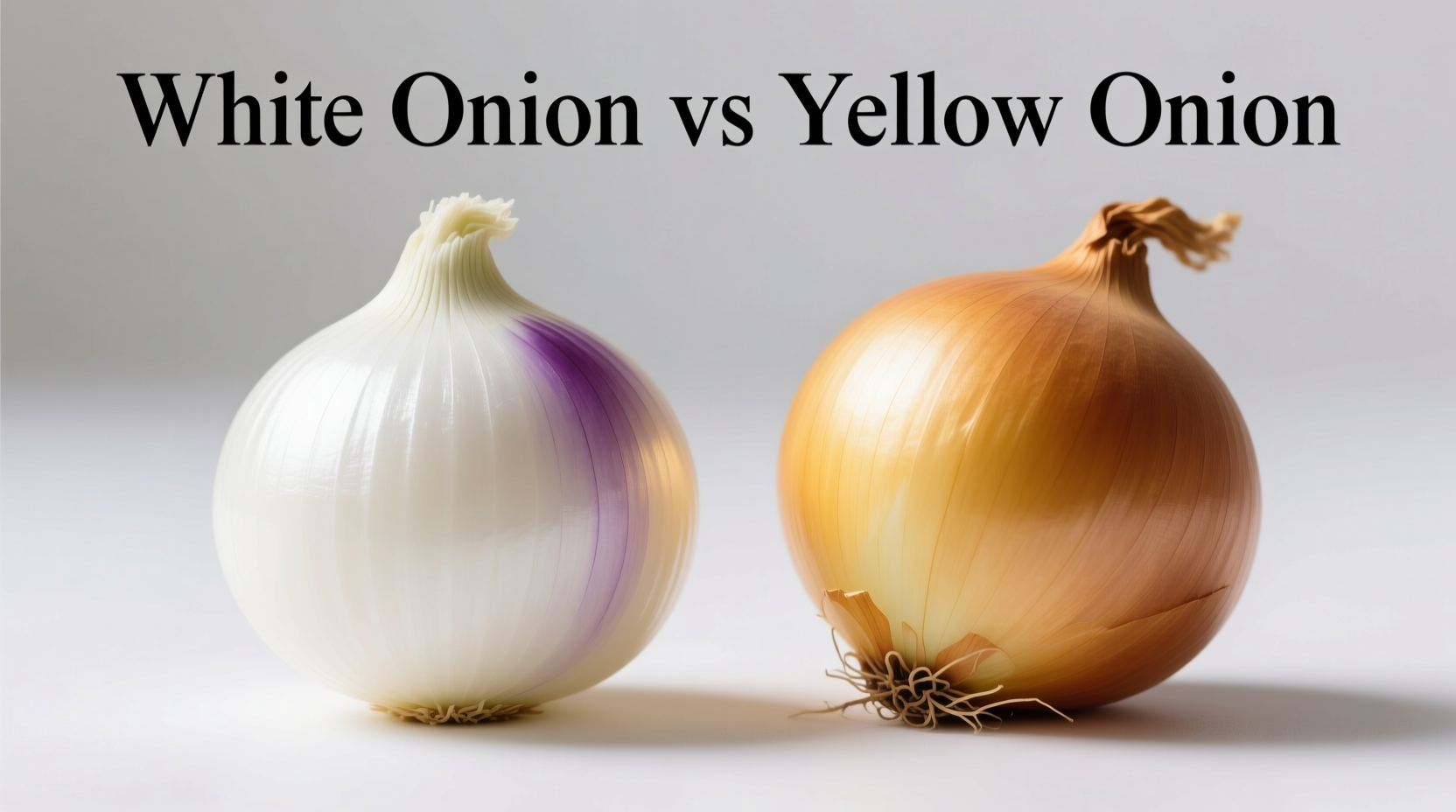Choosing between white and yellow onions can make or break your dish. As a professional chef who's worked with both varieties daily for over 15 years, I've discovered critical differences that home cooks often overlook. This guide reveals exactly when to reach for each type based on scientific properties, cooking behavior, and flavor chemistry—helping you elevate everyday meals with professional precision.
White Onion vs Yellow Onion: Quick Reference Comparison
| Characteristic | White Onion | Yellow Onion |
|---|---|---|
| Flavor Profile | Sharp, pungent, slightly spicy | Mild when raw, sweet when cooked |
| Water Content | Higher (90-92%) | Lower (87-89%) |
| Sugar Content | 4-5% | 7-9% (higher fructose) |
| Best Cooking Methods | Fresh applications, quick cooking | Caramelizing, roasting, slow cooking |
| Shelf Life | 2-3 weeks refrigerated | 2-3 months in cool, dark place |
Flavor Chemistry: Why the Taste Difference Matters
White onions contain higher concentrations of allyl sulfides—the compounds responsible for that sharp, eye-watering bite. According to USDA agricultural research, white onions typically measure 4-5% sugar content compared to yellow onions' 7-9%, with yellow varieties containing more fructose which caramelizes beautifully. This chemical difference explains why white onions maintain their sharpness even when cooked briefly, while yellow onions transform into rich, sweet bases for sauces and stews.
When you slice an onion, you rupture cells containing enzymes that convert sulfoxides into sulfenic acids, which then form syn-propanethial-S-oxide—the gas that makes you cry. White onions produce this compound more readily, creating that characteristic sharpness. For sensitive palates or fresh applications, this makes white onions more assertive, while yellow onions offer a more balanced profile that mellows beautifully with heat.

Cooking Applications: When to Choose Which Onion
Fresh Preparations: White Onion's Domain
For pico de gallo, guacamole, or fresh ceviche, white onions are indispensable. Their crisp texture and sharp flavor cut through rich ingredients without overwhelming them. In Mexican cuisine—which relies heavily on raw onion applications—white onions dominate for good reason. The higher water content keeps salsas bright and refreshing, while the sharper flavor stands up to acidic ingredients like lime juice without fading.
Cooked Dishes: Yellow Onion's Sweet Transformation
When heat enters the equation, yellow onions become the clear winner for most applications. As they cook, the natural sugars caramelize, creating complex flavor compounds that white onions can't match. For French onion soup, you'll need the deeper sweetness only yellow onions provide. The same principle applies to mirepoix, sofrito, and any base that forms the flavor foundation of a dish.
Professional chefs at the Culinary Institute of America note that yellow onions contain more pyruvic acid, which contributes to their superior browning characteristics. When making caramelized onions, yellow varieties typically require 30-40 minutes of slow cooking to develop their full sweetness, while white onions often become unpleasantly bitter if cooked beyond 15-20 minutes.
Nutritional Differences You Should Know
Both varieties offer similar nutritional profiles, but with some noteworthy distinctions. According to USDA FoodData Central, a 100g serving of raw yellow onion contains 41 calories, 1g protein, 9.3g carbohydrates, and 1.7g fiber, while white onions contain 39 calories, 1.1g protein, 8.9g carbohydrates, and 1.4g fiber. The real difference lies in their phytochemical composition.
Yellow onions contain higher levels of quercetin, a flavonoid antioxidant with anti-inflammatory properties. Research published in the Journal of Agricultural and Food Chemistry shows yellow onions contain up to 11 times more quercetin than white varieties. However, white onions contain slightly higher vitamin C content, making them marginally better for immune support in raw applications.
Storage and Shelf Life: Practical Considerations
Yellow onions win hands-down for storage. Their thicker, drier skin allows them to last 2-3 months when stored in a cool, dark place with good air circulation. White onions, with their thinner skins and higher moisture content, typically last only 2-3 weeks even under ideal conditions. For extended storage, refrigeration is necessary for white onions but can actually reduce the shelf life of yellow onions by promoting sprouting.
If you've ever wondered why grocery stores keep white onions in the refrigerated section while yellow onions sit in open bins, this moisture difference explains it. The higher water content in white onions makes them more susceptible to mold and spoilage at room temperature.
Substitution Guidance: When You Can Switch Varieties
While not always interchangeable, substitutions work in certain scenarios:
- Yellow for white: In cooked applications where sharpness isn't critical (like soups or stews), use yellow onions. Reduce quantity by 25% to account for milder flavor.
- White for yellow: In fresh salsas or salads where sharpness is desired, white onions work well. For cooked dishes, add 1/4 teaspoon sugar per onion to compensate for lower natural sweetness.
- Never substitute: In traditional Mexican pico de gallo or French onion soup—these dishes rely on the specific characteristics of each onion variety.
Avoid These Common Onion Mistakes
Even experienced home cooks make these critical errors:
- Using white onions for caramelizing: Their higher water content prevents proper browning and creates a bitter aftertaste.
- Storing cut onions in metal containers: This accelerates spoilage regardless of onion type—always use glass or plastic.
- Chopping onions without chilling first: For both varieties, refrigerating onions for 30 minutes before cutting significantly reduces tear-inducing compounds.
- Using the wrong knife: A sharp chef's knife creates cleaner cuts that release fewer enzymes—dull knives cause more cellular damage and more tears.
Regional Usage Patterns: Culinary Traditions
Understanding regional preferences reveals why certain cuisines favor specific onions. In Mexico and much of Latin America, white onions dominate fresh preparations—their sharp bite complements spicy chilies and acidic lime perfectly. Meanwhile, European and American cuisines traditionally rely on yellow onions for cooked dishes, where their sweet transformation enhances sauces, soups, and roasted meats.
This isn't arbitrary—these traditions developed based on available varieties and how each onion's chemistry complements other ingredients in the cuisine. When making authentic dishes, respecting these traditions matters more than personal preference.
Frequently Asked Questions
Can I substitute white onions for yellow onions in soup?
Yes, but with adjustments. White onions work in clear broths where sharpness is desirable, but for creamy soups or those requiring caramelization, yellow onions are superior. If substituting, use 25% less white onion and add 1/4 teaspoon sugar per onion to compensate for lower natural sweetness.
Why do recipes specify white onions for salsa?
White onions provide the sharp, clean bite that balances acidic tomatoes and lime juice in fresh salsas. Their higher water content keeps the salsa bright and refreshing, while yellow onions would become unpleasantly sweet and muddy the flavors when combined with acidic ingredients.
Which onion is healthier, white or yellow?
Both offer similar nutritional benefits, but yellow onions contain up to 11 times more quercetin—a powerful antioxidant with anti-inflammatory properties—according to USDA research. White onions have slightly more vitamin C, making them marginally better for immune support in raw applications. For maximum health benefits, include both varieties in your diet.
How do I reduce tears when cutting onions?
Chill onions in the refrigerator for 30 minutes before cutting to slow enzyme activity. Use a sharp knife for cleaner cuts that release fewer tear-inducing compounds. Cutting under running water or near a fan can also help disperse the volatile compounds. Professional chefs often recommend wearing swim goggles for serious onion work!
Why do my caramelized onions turn bitter?
Bitter caramelized onions usually result from using white onions (which contain compounds that turn bitter when cooked too long) or cooking at too high a temperature. Always use yellow onions for caramelizing, cook over medium-low heat, and be patient—proper caramelization takes 30-40 minutes. Adding a pinch of baking soda can speed the process while preventing bitterness.











 浙公网安备
33010002000092号
浙公网安备
33010002000092号 浙B2-20120091-4
浙B2-20120091-4